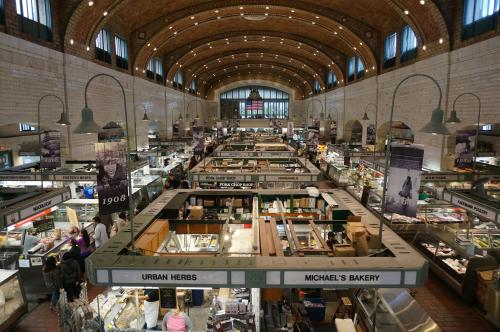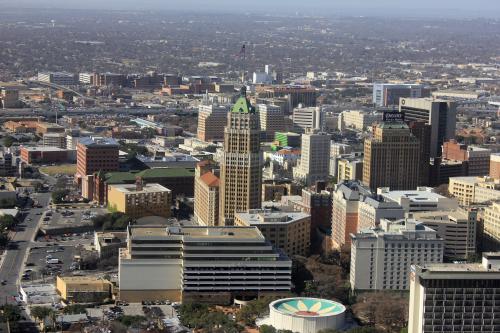This speech was delivered at the Texas Association of Urban Counties Annual Education Conference in Austin, Texas on January 12, 2017.
Several years ago, Jennifer Bradley and I co-authored a book entitled “The Metropolitan Revolution“.
The thesis was simple and straightforward.
In the aftermath of the Great Recession, U.S. cities, counties, and metros had recognized that with our federal government mired in partisan gridlock and most states adrift, they were essentially on their own to grapple with super-sized economic, social, and environmental challenges. The cavalry was not coming. Washington was not riding to the rescue.
Fortunately, cities and metros – and the networks of leaders who govern them – mayors and county leaders for sure but also business, civic, community, business, labor, and environmental leaders –responded with pragmatism, energy, and ambition to “get stuff done”.
These leaders were stepping up and doing the hard work to grow jobs and restructure the economy for the long haul. Lacking any choice, they were innovating on the big stuff: policies and practices that drive the wealth-generating, trade-able sectors of the economy.
In Denver and Los Angeles, they were investing in transformative infrastructure, like state of the art transit to ensure mobility and the expansion ports and airports and broadband to enhance connectivity.
In Cleveland and Fremont, CA (where Tesla is located), they were making manufacturing a priority again … and creating tight ecosystems of firms, business associations, labor, universities, and new intermediaries.
In Portland and Minneapolis-St. Paul, they were devising export plans, connecting small businesses to global markets, and forging strong relationships with trading partners in mature and rising economies alike.
In Houston and Chicago, they were integrating immigrants and giving workers the skills they need.
In Atlanta and Pittsburgh, they were creating vibrant innovation districts around anchor institutions like universities and medical campuses.
And in New York City, economic development had fundamentally shifted from subsidizing sports stadia to attracting world class technology universities … to provide a platform for generations of growth.
America, in short, was remaking itself from the bottom up.
Well that was the world circa 2013.
The metropolitan revolution emerged in a vacuum left by gridlocked and balkanized national and state governments. Cities and counties were stepping up to act on issues – infrastructure investments, immigrant integration – that higher levels of government could not or would not tackle.
The metropolitan revolution assumed that higher levels of government were dysfunctional but stable. All of us in this room know that when the federal or state governments go into gridlock, the checks still keep coming and the rules still keep regulating.
The metropolitan revolution, as initially conceived, assumed a stable platform of national investments and rulemaking upon which new urban innovations could be based.
Today I want to talk about the radically different environment in which we find ourselves.
The Trump election has fundamentally upended any notion of policy stability. After years of federal inaction and drift, we are about to enter a period of quick, aggressive and decisive federal action.
What if Trump and Congress actually repeal the Affordable Care Act or block grant Medicaid and food stamps?
What if Trump and Congress place caps on spending and cut funding for discretionary programs as diverse as housing and education, health and military research and workforce development, homelessness, and Head Start?
What if the Trump and Congress move forward with radical immigration, environmental, and consumer protection reforms?
In the United States, we could be witnessing the most radical reshaping of federalism – the division of responsibilities across multiple levels of government – since the New Deal.
And this is going to happen during a period when, by conservative estimates, the nation faces an investment deficit of $3-4 trillion over the next decade.
We must invest more in basic science and applied research so that the United States continues to lead the world on the invention, deployment, production, and adoption of next generation technologies like autonomous vehicles and personalized medicine.
We must retrofit our crumbling 20th Century physical infrastructure – our water and sewer systems, our energy grid, our freeways that are coming to the end of their useful life – and create new state-of-the-art transit and communication systems that are aligned with the 21st century.
We must deal with the rising share of elderly in our population, which will affect not just our health care and pension systems but the very shape and structure of our communities.
And we must create better opportunities for our children through quality early education, more effective schools and cutting edge skills training.
That’s the reality in 2016. The fiscal writing is essentially on the wall. Going forward, cities and counties will be increasingly responsible for investing in our nation’s future, including, most importantly, infrastructure, housing, quality places, and the schooling and skilling of children and young adults.
What this means is that we need a metropolitan revolution on steroids.
Cities and counties … and their states … are going to be tested like they have never been before.
They are going to need to innovate and reform in ways that we can scarcely imagine.
They will need to pursue new patterns of urban growth, new forms of urban finance, and new norms of urban governance that are concrete, imaginative, integrated and, ultimately, transferable.
To do so, they will need new tools and rules, structures and systems to individually leverage their distinctive assets and collectively aggregate their political and market power.
They will need to invent, in short, a new localism that responds to this uncertain area and their heightened importance.
I feel so strongly about this that I have committed myself to a completely masochistic exercise – writing a book by this summer tentatively titled “The New Localism: How Cities and Metropolitan Areas Triumph in the Age of Trump”. Fortunately, I have found another masochist to share my pain – Jeremy Nowak, the founder and former head of The Reinvestment Fund in Philadelphia, one of the most sophisticated community development finance institutions in the U.S. and the world.
Jeremy and I fundamentally believe that cities and urban counties in the United States have what it takes to survive and thrive.
They are the engines of the U.S. economy and the centers of global trade and investment;
They sit on the front lines of demographic transformation, global migration, and environmental change; and they are the vanguard of policy innovation and social progress.
And they are capable of leading this nation because they are endowed with market power and relevance:
Economic restructuring and the demographic preferences of talented workers have revalued proximity, density, diversity and vitality – cities and urban counties – rather than favoring dispersion and decentralization.
The accelerated pace of innovation has reinforced the benefits of agglomeration and propinquity and enabled cities like Pittsburgh to be first movers on next generation technologies like autonomous vehicles and robotics.
Unlike the federal and state governments, cities and counties are NOT governments but rather networks of institutions and leaders that collaborate to problem solve – across disciplines, across jurisdictions, across sectors. They are natural engines of continuous innovation and learning.
That said, city and county governments, particularly compared to counterparts in many European nations, have enormous powers and responsibilities – they are nation’s lead investors in key levers of competitiveness and social mobility – infrastructure, children, schools, and skills.
Finally, cities and counties both exist within and transcend nations and states (given the movement of global capital and the location preferences of global corporations and talent).
I fundamentally believe that we are on the verge of a burst of new localism in the United States.
I fundamentally believe that federal activism will force and compel cities and counties to do what they do best – innovate in the face of adversity and create new norms of growth, governance and finance.
What will this look like in specific?
Let’s take an area that everyone in this room knows well – finance.
By conservative estimates, U.S. and European cities will need to invest trillions of dollars over the next decade to address pressing economic, demographic, and environmental challenges. Traditional public finance resources and tools are inadequate to meet this demand because of what I discussed before – the rising share of elderly people in our populations and the rising share that health care and retirement benefits make up of national government budgets, crowding out investments in other domestic activities.
To accomplish this, cities and metropolitan areas will require financing in many forms and from a variety of public, private, and civic sources, often pooled and combined in intricate ways. In essence, a new field of what I call “metropolitan finance” will be needed to aggregate and deploy public, civic, and private capital across multiple dimensions.
The heart of this new metropolitan finance will be the creation of new instruments, intermediaries and institutions to unlock the public, private, and civic capital necessary for transformative urban investments.
New Financial Instruments
Cities and metropolitan areas … and a broad range of investors … must invent new financial instruments and practices to channel capital toward a number of sustainable and inclusive activities. In the U.S., much attention is being paid to impact investing and the rise of Pay for Success Bonds, recently used in Salt Lake County to expand pre-kindergarten to economically disadvantaged children. This reflects the broader invention of organizations and funds that are geared to generate measurable, beneficial social and environmental impacts alongside financial returns.
Yet new instruments and mechanisms are springing up in many other areas of policy. Green Bonds have emerged as a means of funding clean energy and energy efficiency projects. Pension funds are also beginning to treat large urban redevelopment projects like London’s Kings Cross as a single asset class, recognizing the synergistic effect of disparate investments that strengthen and reinforce each other’s value, rather than as a collection of separate and unrelated investments.
This is a major departure from the status quo where large commercial banks and governmental agencies compartmentalize all aspects of financing (equity investments, debt lending, and grant making just to name a few) even though the focus of these investments (e.g., housing, infrastructure, small business) are physically located in small geographies and interact in a way that enhances value for each of the disparate elements.
New Intermediaries
Second, cities and metropolitan areas will need to create new intermediaries that can more seamlessly link local and non-local capital to needed investments.
In King and Broward Counties, Children Cabinets have being created to just bring coherence to the disparate federal and state funding streams but to go to the ballot box and raise a predictable stream of public resources for targeted investment in proven children and youth programs.
In Detroit, an intermediary called Invest Detroit has established a series of funds (e.g., a Predevelopment Loan Fund, an Urban Retail Fund, a Lower Woodward Housing Fund, a New Markets Tax Credit Fund) that try to match the expectations of private and civic investors with the financing needs of small- and medium-sized firms that serve different market functions in the downtown and midtown area.
In Cambridge, MA, incubators like the Cambridge Innovation Center have matched startups to experts and seed capital. Hubs like Chicago’s 1871 have paired large companies like United and State Farm with entrepreneurial firms and talent.
Other intermediaries like the Texas Medical Center in Houston are acting as the connective tissue between large anchor institutions (like hospitals and universities) to achieve greater innovation through collaboration.
New Publicly Owned, Privately Managed Institutions:
Finally, cities and metropolitan areas will need to form new kinds of special-purpose publicly owned, but privately managed institutions to unlock the value of underutilized public assets and finance a wide range of transformative projects. In Hamburg, a company owned by the city government, is overseeing the redevelopment of HafenCity, the largest inner city regeneration effort in Europe through the redevelopment of former port and industrial sites. In Copenhagen, CPH City and Port Development, a company jointly owned by the municipal and national governments, is developing areas along the waterfront. In the United States and elsewhere, Community Land Trusts have provided stable foundations for affordable housing. And CORTEX in St. Louis and 22@ in Barcelona have governed the build out of innovation districts in those two cities.
Many of these new entities use innovative mechanisms to capture upfront the anticipated value appreciation of local property from improved infrastructure, thereby making available resources to finance the market shaping improvements. Many U.S. cities already use tax increment financing (i.e., “TIFs”) to support infrastructure projects by borrowing against the future stream of additional tax revenue the project is expected to generate. For example, a TIF was used to finance infrastructure improvements for the Atlantic Station project in Atlanta, a streetcar in Portland, and urban renewal projects in Fort Worth. Many cities also use land use and zoning changes to enhance the market value of properties in downtown, midtown, and waterfront areas thereby unleashing private investment.
These examples represent a mix of innovative finance tools, partnerships, and approaches, yet they illustrate several defining elements of the new metropolitan finance:
First, the new metropolitan finance reflects the fact that cities and metropolitan areas are not just governments but networks of institutions and leaders that cut across sectors as well as jurisdictional and disciplinary lines. The financing potential of cities, therefore, does not rely exclusively on the balance sheets of local governments or authorities. Rather, it is the balance sheets and asset bases of a broad set of stakeholders that are used to make important investments in the drivers of productive, inclusive, and resilient growth (innovation, infrastructure, skilled workers).
Second, the new metropolitan finance provides a proper accounting of the role that a range of public, private, and civic investors play in building cities and metropolitan areas. Although much focus is placed on federal investments or the health of municipal government finances, the fact is that many elements of local and metropolitan infrastructure are already designed, financed, and delivered through a range of private and private/public institutions including utilities, telecommunication firms, special quasi-public authorities, and major anchor institutions.
Finally, the new metropolitan finance reflects the multi-dimensional reality of city and metropolitan growth and the multi-layered nature of many complex financial transactions. The fact is that that cities and metropolitan areas require financing in many forms and from a variety of sources, often pooled and combined together in intricate mixes, to shape their economies, make quality places, and equip their workers with the skills they need to compete.
Conclusion
Let me conclude with these thoughts.
I believe that the coming decade will stimulate, by sheer necessity, a new localism in the United States.
It will build on the incredible economic, fiscal, financial, and social attributes that cities and urban counties have in this country.
It will stimulate innovations in growth, governance, and finance that are specific and tangible and then are adapted, tailored, and replicated at lightening speed.
It will, if designed smartly and implemented well, be a pathway to national renewal and a more competitive, sustainable, and inclusive society.
It can yield better solutions to hard challenges since it matches problem solving to the way world works (integrated, holistic, entrepreneurial rather than compartmentalized, siloed, bureaucratic)
It can be a more efficient and effective use of public resources since it is more aligned with market demand (and the distinctive assets/priorities/needs of different metros) rather than political log rolling.
It can unlock and leverage trillions in private and civic capital as markets are created and individuals and institutions find ways to invest in social outcomes. It is a path towards liberating and galvanizing energy and capital across the nation – to particularly invest in our future.
It can be more democratic since it puts decision making closer to the ground with more opportunities for participatory engagement on a regular basis rather than periodic voting.
It can be a path back to political comity and sanity since it will restore faith in government as citizens see solutions to pressing challenges actually happen rather than debated by polarized parties and ideologies.
I look forward to working with the National Association of Counties in general and the Texas Association of Urban Counties in specific to design and deliver a new localism in this great country of ours.
The Brookings Institution is committed to quality, independence, and impact.
We are supported by a diverse array of funders. In line with our values and policies, each Brookings publication represents the sole views of its author(s).










Commentary
The new localism: How cities and metropolitan areas triumph in the age of Trump
January 18, 2017